
Joseph Barnard Davis (1801 – 19 May 1881) was an English medical doctor now remembered as a collector and craniologist.

Joseph Barnard Davis (1801 – 19 May 1881) was an English medical doctor now remembered as a collector and craniologist.
In the summer of 1820, while still a student, he went as a surgeon in a whaling ship to the Arctic seas. Obtaining the Apothecaries' Hall qualification in 1823, it was not till twenty years later that he became a member of the College of Surgeons. In 1862 he graduated M.D. at the University of St Andrews. He early settled at Albion Street Shelton, Staffordshire (now Hanley), and was a medical practitioner till his death on 19th May 1881. He was elected a Fellow of the Royal Society in 1868. [1]

The Worshipful Society of Apothecaries of London is one of the livery companies of the City of London. It is one of the largest livery companies and ranks 58th in their order of precedence.

The University of St Andrews is a British public university in St Andrews, Fife, Scotland. It is the oldest of the four ancient universities of Scotland and the third oldest university in the English-speaking world. St Andrews was founded between 1410 and 1413, when the Avignon Antipope Benedict XIII issued a papal bull to a small founding group of Augustinian clergy.

Shelton is an area of the city of Stoke-on-Trent in Staffordshire, England, between Hanley and Stoke-upon-Trent.
He was active in local life and was an important member of the Athenaeum, Stoke-upon-Trent. As such he played a part in establishing the first Museum of the Natural History, Pottery and Antiquities.
In 1836 he published a Popular Manual of the Art of Preserving Health. [1]
Davis collected a museum of skulls and skeletons of various races, nearly all with histories; [1] it was larger than all the collections in British public museums put together, numbering 1474 in 1867. [2] His personal collection began with two skulls bought from Matthew Moorhouse in 1848. [3] He purchased from the collection of James De Ville (Deville), a phrenologist. [4] He corresponded with travellers, collectors, and residents in foreign countries. In 1856 he began with John Thurnam, the publication of Crania Britannica: delineations and descriptions of the skulls of the aboriginal and early inhabitants of the British islands, with text, plates and an accompanying atlas. The work was completed in 1865.

Matthew Moorhouse was a mass murderer, an English pioneer in Australia, pastoralist, politician, and Protector of Aborigines in South Australia. He led the Rufus River massacre, where he and his men murdered 30-40 Maraura men, women and children.
John Thurnam was an English psychiatrist, archaeologist, and ethnologist. He was Medical Superintendent of The Retreat, the Quaker psychiatric hospital near York. In 1848 he reported two maternal first cousins with an unusual condition affecting the skin, hair and teeth ; he had performed an examination post mortem on one of the two men, including relevant histopathology.
In 1867 he published a catalogue of the collection called Thesaurus Craniorum, describing and figuring many specimens, and giving 25,000 measurements. In 1875 a supplement to the Thesaurus was published. In 1879 or 1880 the Royal College of Surgeons purchased the collection, then numbering 1800 crania and some skeletons. [1] [5]
A Royal College of Surgeons or Royal Surgical College is a type of organisation found in many present and former members of the Commonwealth of Nations. These organisations are responsible for training surgeons and setting their examinations. In this context, the term chartered implies the awarding of a Royal charter.
As well as his collection of human remains, Davis was an avid collector of books, photographs, prints, drawings and artefacts relating to many cultural groups. Amongst his collection were works of art and artefacts collected originally by George Augustus Robinson from Tasmania and from the state of Victoria, Australia. The Australian works were mainly purchased by Davis after Robinson’s death from Robinson’s widow. [6] Davis also bought art works relating to Tasmanian Aborigines directly from the artist John Skinner Prout. [7]

George Augustus Robinson was a British builder and untrained preacher. He was the Chief Protector of Aborigines in Port Phillip District, from 1839 to 1849. Prior to this appointment by the Colonial Office in Great Britain, he had been called upon to mount a "friendly mission" to find the 300 remaining Aboriginals in Tasmania.
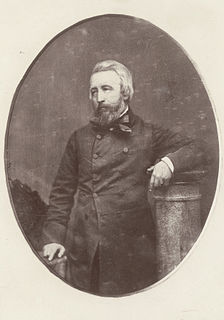
John Skinner Prout (1805–1876) was a British painter, writer, lithographer and art teacher.
He was also interested in the most ancient history of his local north Staffordshire, having a collection of the rare carved runic calendar sticks from the north part of the county. He published a detailed article on these, “Some Account of Runic Calendars and Staffordshire Clogg Almanacs”, Archaologia, Vol. XLI, Part II, 1867, pages 453-478.
For some years from 1870 he was one of the editors of the Journal of Anthropology , and of Anthropologia . [1]
Davis’s collection was dispersed after his death through a series of auctions in London at Sotheby’s in 1883. Many works relating to Oceania, Asia, the Americas and Africa were purchased by A W Franks and given to the British Museum in the late 1880s and 1890s. [8] [9]
Davis was a critic of the idea of human speciation. He believed that comparative anatomy would demonstrate that racial differences were immutable. [10] He supported anti-evolutionary views, and presented a paper to the British Association for the Advancement of Science in 1868, on brain weight, [11] publishing Contributions towards Determining the Weight of the Brain in Different Races of Man ( Philosophical Transactions , 1868, clviii. 505–28). In an 1869 paper On the Weight of the Brain in the Negro he argued that brain weight was a racial characteristic. [12]
A polygenist, he drew conclusions on the intellectual capacities of the Australian Aborigines, in particular, from his collection. [13] A motivation for his collecting was his belief that the morphology of the Australian remains provided indications of a separate origin. [14]
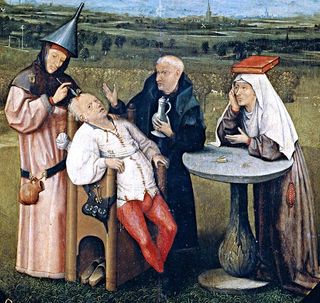
Trepanning, also known as trepanation, trephination, trephining or making a burr hole is a surgical intervention in which a hole is drilled or scraped into the human skull, exposing the dura mater to treat health problems related to intracranial diseases or release pressured blood buildup from an injury. It may also refer to any "burr" hole created through other body surfaces, including nail beds. It is often used to relieve pressure beneath a surface. A trephine is an instrument used for cutting out a round piece of skull bone.
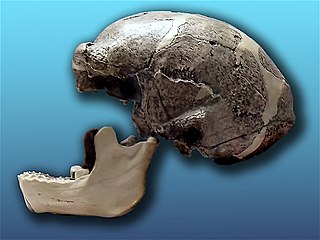
Peking Man, Homo erectus pekinensis, is an example of Homo erectus. Discovered in 1923–27 during excavations at Zhoukoudian near Beijing, China, in 2009 this group of fossil specimens dated from roughly 750,000 years ago, and a new 26Al/10Be dating suggests they are in the range of 680,000–780,000 years old.

Yagan was an Indigenous Australian warrior from the Noongar people. He played a key part in early resistance to British colonial settlement and rule in the area surrounding what is now Perth, Western Australia. Yagan was pursued by the local authorities after he killed Erin Entwhistle, a servant of farmer Archibald Butler. It was an act of retaliation after Thomas Smedley, another of Butler's servants, shot at a group of Noongar people stealing potatoes and fowls, killing one of them. The government offered a bounty for Yagan's capture, dead or alive, and a young settler, William Keats, subsequently shot and killed him. Yagan's execution figures in Australian history as a symbol of the unjust and sometimes brutal treatment of the indigenous peoples of Australia by colonial settlers. He is considered a hero by the Noongar.

A skull and crossbones or death's head is a symbol consisting of a human skull and two long bones crossed together under or behind the skull. The design originates in the Late Middle Ages as a symbol of death and especially as a memento mori on tombstones.
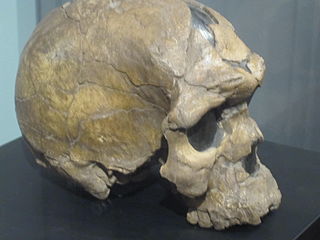
Homo sapiens idaltu, also called Herto Man, is the name given to a number of early modern human fossils found in 1997 in Herto Bouri, Ethiopia. They date to around 160,000 years ago.
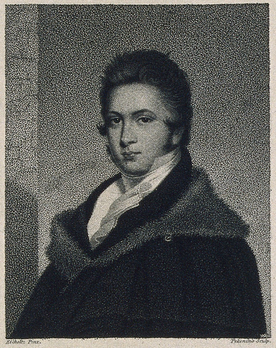
Richard Harlan was an American naturalist, zoologist, herpetologist, physicist, and paleontologist. He was the author of Fauna Americana, published in 1825, and American Herpetology.

Sir William Henry Flower was an English surgeon, museum curator and comparative anatomist, who became a leading authority on mammals and especially on the primate brain. He supported Thomas Henry Huxley in an important controversy with Richard Owen about the human brain and eventually succeeded Owen as Director of the Natural History Museum in London.

Craniometry is measurement of the cranium, usually the human cranium. It is a subset of cephalometry, measurement of the head, which in humans is a subset of anthropometry, measurement of the human body. It is distinct from phrenology, the pseudoscience that tried to link personality and character to head shape, and physiognomy, which tried the same for facial features. However, these fields have all claimed the ability to predict traits or intelligence.
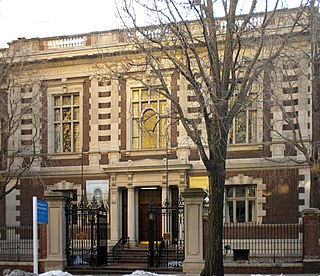
The Mütter Museum is a medical museum located in the Center City area of Philadelphia, Pennsylvania. It contains a collection of anatomical and pathological specimens, wax models, and antique medical equipment. The museum is part of The College of Physicians of Philadelphia. The original purpose of the collection, donated by Dr. Thomas Dent Mutter in 1858, was for biomedical research and education.

Australopithecus africanus is an extinct (fossil) species of the australopithecines, the first of an early ape-form species to be classified as hominin. Recently it was dated as living between 3.3 and 2.1 million years ago, or in the late Pliocene and early Pleistocene times; it is debated as being a direct ancestor of modern humans. A. africanus was of slender, or gracile, build and has been found only in southern Africa at four sites: Taung (1924), Sterkfontein (1935), Makapansgat (1948) and Gladysvale (1992).

Samuel George Morton was an American physician, natural scientist, and writer. Morton, who was raised a Quaker but became Episcopalian in midlife, was born in Philadelphia, Pennsylvania, attended Westtown School, and graduated from the University of Pennsylvania in 1820. After earning an advanced degree from the University of Edinburgh in Scotland, he began practice in Philadelphia in 1824. He was one of the founders of the Pennsylvania Medical College in Philadelphia and served as its professor of anatomy from 1839 until his resignation in 1843. He was elected a member of the American Antiquarian Society in 1844.
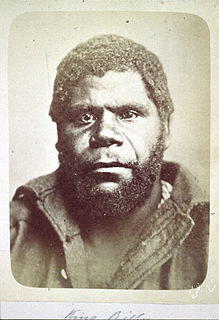
William Lanne was a Tasmanian Aboriginal. He is most well known as the last 'full-blooded' Aboriginal Tasmanian man.

Gough's Cave is located in Cheddar Gorge on the Mendip Hills, in Cheddar, Somerset, England. The cave is 115 m (377 ft) deep and is 3.405 km (2.12 mi) long, and contains a variety of large chambers and rock formations. It contains the Cheddar Yeo, the largest underground river system in Britain.

The Kow Swamp archaeological site comprises a series of late Pleistocene burials within the lunette of the eastern rim of a former lake known as Kow Swamp. The site is located 10 km south-east of Cohuna in the central Murray River valley, in northern Victoria, at 35.953553°S 144.318123°E. The site is significant for archaeological excavations by Alan Thorne between 1968 and 1972 which recovered the partial skeletal remains of more than 22 individuals.

Skull of a Skeleton with Burning Cigarette is an early work by Vincent van Gogh. The small and undated oil-on-canvas painting featuring a skeleton and cigarette is part of the permanent collection of the Van Gogh Museum in Amsterdam. It was most likely painted in the winter of 1885–86 as a satirical comment on conservative academic practices. Before it was common to use live humans as models, the academic routine included the study of skeletons to develop an understanding of human anatomy. Van Gogh was in Antwerp, Belgium at that time attending classes at the Royal Academy of Fine Arts, which he later said were boring and taught him nothing.
The history of anthropometry includes the use of anthropometry as an early tool of physical anthropology, use for identification, use for the purposes of understanding human physical variation, in paleoanthropology, and in various attempts to correlate physical with racial and psychological traits. At various points in history, certain anthropometrics have been cited by advocates of discrimination and eugenics, often as part of novel social movements or based upon pseudoscientific claims.
Professor Richard James Arthur Berry FRSE FRCSE (1867–1962) was a British-born surgeon and anatomist who was well-known in Australia. He was author of several internationally recognised books in his field.
Miriam Louise Tildesley was an English anthropologist.

CranID was created in 1992 by anthropologist Richard Wright of the University of Sydney to infer the probable geographic origin of unknown crania that are found in archaeological, forensic and repatriation cases. Wright created the program to establish uniformity in cranial morphology based on the assumption that there is a high correlation between geographical location and cranial morphology. This was the first standardized program to evaluate the similarity and dissimilarity of cranial morphological characteristics of an unknown cranium and the database.
![]()